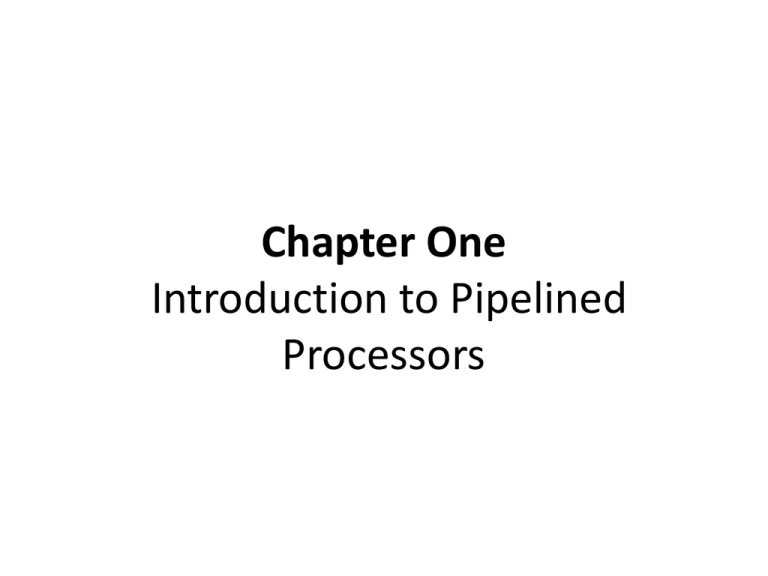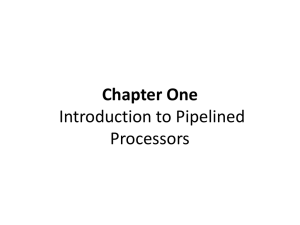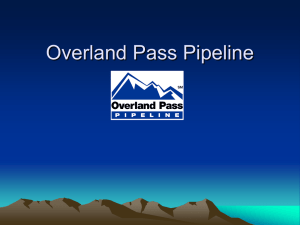Document
advertisement

Chapter One Introduction to Pipelined Processors Non-linear pipeline • In floating point adder, stage (2) and (4) needs a shift register. • We can use the same shift register and then there will be only 3 stages. • Then we should have a feedback from third stage to second stage. • Further the same pipeline can be used to perform fixed point addition. • A pipeline with feed-forward and/or feedback connections is called non-linear Example: 3-stage nonlinear pipeline 3 stage non-linear pipeline Output A Input Sa Output B Sb Sc • It has 3 stages Sa, Sb and Sc and latches. • Multiplexers(cross circles) can take more than one input and pass one of the inputs to output • Output of stages has been tapped and used for feedback and feed-forward. 3 stage non-linear pipeline • The above pipeline can perform a variety of functions. • Each functional evaluation can be represented by a particular sequence of usage of stages. • Some examples are: 1. Sa, Sb, Sc 2. Sa, Sb, Sc, Sb, Sc, Sa 3. Sa, Sc, Sb, Sa, Sb, Sc Reservation Table • Each functional evaluation can be represented using a diagram called Reservation Table(RT). • It is the space-time diagram of a pipeline corresponding to one functional evaluation. • X axis – time units • Y axis – stages Reservation Table • For first sequence Sa, Sb, Sc, Sb, Sc, Sa called function A , we have Sa Sb Sc 0 A 1 2 A 3 4 A A A 5 A Reservation Table • For second sequence Sa, Sc, Sb, Sa, Sb, Sc called function B, we have Sa Sb Sc 0 B 1 2 B B 3 B 4 5 B B 3 stage non-linear pipeline Output A Input Output B Sa Sc Reservation Table Time Stage 0 Sa Sb Sc Sb 1 2 3 4 5 Function A 3 stage pipeline : Sa, Sb, Sc, Sb, Sc, Sa Output A Input Output B Sa Sb Sc Reservation Table Time Stage Sa Sb Sc 0 A 1 2 3 4 5 3 stage pipeline : Sa, Sb, Sc, Sb, Sc, Sa Output A Input Output B Sa Sc Reservation Table Time Stage Sa Sb Sc Sb 0 A 1 A 2 3 4 5 3 stage pipeline : Sa, Sb, Sc, Sb, Sc, Sa Output A Input Output B Sa Sc Reservation Table Time Stage Sa Sb Sc Sb 0 A 1 2 A A 3 4 5 3 stage pipeline : Sa, Sb, Sc, Sb, Sc, Sa Output A Input Output B Sa Sc Reservation Table Time Stage Sa Sb Sc Sb 0 A 1 2 A 3 A A 4 5 3 stage pipeline : Sa, Sb, Sc, Sb, Sc, Sa Output A Input Output B Sa Sc Reservation Table Time Stage Sa Sb Sc Sb 0 A 1 2 A 3 4 A A A 5 3 stage pipeline : Sa, Sb, Sc, Sb, Sc, Sa Output A Input Output B Sa Sc Reservation Table Time Stage Sa Sb Sc Sb 0 A 1 2 A 3 4 A A A 5 A Function B 3 stage pipeline: Sa, Sc, Sb, Sa, Sb, Sc Output A Input Output B Sa Sc Reservation Table Time Stage Sa Sb Sc Sb 0 B 1 2 3 4 5 3 stage pipeline: Sa, Sc, Sb, Sa, Sb, Sc Output A Input Output B Sa Sc Reservation Table Time Stage Sa Sb Sc Sb 0 B 1 B 2 3 4 5 3 stage pipeline: Sa, Sc, Sb, Sa, Sb, Sc Output A Input Output B Sa Sc Reservation Table Time Stage Sa Sb Sc Sb 0 B 1 2 B B 3 4 5 3 stage pipeline: Sa, Sc, Sb, Sa, Sb, Sc Output A Input Output B Sa Sc Reservation Table Time Stage Sa Sb Sc Sb 0 B 1 2 B B 3 B 4 5 3 stage pipeline: Sa, Sc, Sb, Sa, Sb, Sc Output A Input Output B Sa Sc Reservation Table Time Stage Sa Sb Sc Sb 0 B 1 2 B B 3 B 4 B 5 3 stage pipeline: Sa, Sc, Sb, Sa, Sb, Sc Output A Input Output B Sa Sc Reservation Table Time Stage Sa Sb Sc Sb 0 B 1 2 B B 3 B 4 5 B B Reservation Table • After starting a function, the stages need to be reserved in corresponding time units. • Each function supported by multifunction pipeline is represented by different RTs • Time taken for function evaluation in units of clock period is compute time.(For A & B, it is 6) Reservation Table • Marking in same row => usage of stage more than once • Marking in same column => more than one stage at a time Multifunction pipelines • Hardware of multifunction pipeline should be reconfigurable. • Multifunction pipeline can be static or dynamic Multifunction pipelines • Static: – Initially configured for one functional evaluation. – For another function, pipeline need to be drained and reconfigured. – You cannot have two inputs of different function at the same time Multifunction pipelines • Dynamic: – Can do different functional evaluation at a time. – It is difficult to control as we need to be sure that there is no conflict in usage of stages. Principle of Designing Pipeline Processors (Design Problems of Pipeline Processors) Instruction Prefetch and Branch Handling • The instructions in computer programs can be classified into 4 types: – Arithmetic/Load Operations (60%) – Store Type Instructions (15%) – Branch Type Instructions (5%) – Conditional Branch Type (Yes – 12% and No – 8%) Instruction Prefetch and Branch Handling • Arithmetic/Load Operations (60%) : – These operations require one or two operand fetches. – The execution of different operations requires a different number of pipeline cycles Instruction Prefetch and Branch Handling • Store Type Instructions (15%) : – It requires a memory access to store the data. • Branch Type Instructions (5%) : – It corresponds to an unconditional jump. Instruction Prefetch and Branch Handling • Conditional Branch Type (Yes – 12% and No – 8%) : – Yes path requires the calculation of the new address – No path proceeds to next sequential instruction. Instruction Prefetch and Branch Handling • Arithmetic-load and store instructions do not alter the execution order of the program. • Branch instructions and Interrupts cause some damaging effects on the performance of pipeline computers. Handling Example – Interrupt System of Cray1 Cray-1 System • The interrupt system is built around an exchange package. • When an interrupt occurs, the Cray-1 saves 8 scalar registers, 8 address registers, program counter and monitor flags. • These are packed into 16 words and swapped with a block whose address is specified by a hardware exchange address register Instruction Prefetch and Branch Handling • In general, the higher the percentage of branch type instructions in a program, the slower a program will run on a pipeline processor. Effect of Branching on Pipeline Performance • Consider a linear pipeline of 5 stages Fetch Instruction Decode Fetch Operands Execut e Store Results Overlapped Execution of Instruction without branching I1 I2 I3 I4 I5 I6 I7 I8 I5 is a branch instruction I1 I2 I3 I4 I5 I6 I7 I8 Estimation of the effect of branching on an n-segment instruction pipeline Estimation of the effect of branching • Consider an instruction cycle with n pipeline clock periods. • Let – p – probability of conditional branch (20%) – q – probability that a branch is successful (60% of 20%) (12/20=0.6) Estimation of the effect of branching • Suppose there are m instructions • Then no. of instructions of successful branches = mxpxq (mx0.2x0.6) • Delay of (n-1)/n is required for each successful branch to flush pipeline. Estimation of the effect of branching • Thus, the total instruction cycle required for m instructions = 1 mpq (n 1) n m 1 n n Estimation of the effect of branching • As m becomes large , the average no. of instructions per instruction cycle is given as Lt m m n m 1 m pq(n 1) n = n ? Estimation of the effect of branching • As m becomes large , the average no. of instructions per instruction cycle is given as Lt m m n m 1 m pq(n 1) n n 1 pq(n 1) n Estimation of the effect of branching • When p =0, the above measure reduces to n, which is ideal. • In reality, it is always less than n. Solution = ? Multiple Prefetch Buffers • Three types of buffers can be used to match the instruction fetch rate to pipeline consumption rate 1. Sequential Buffers: for in-sequence pipelining 2. Target Buffers: instructions from a branch target (for out-of-sequence pipelining) Multiple Prefetch Buffers • A conditional branch cause both sequential and target to fill and based on condition one is selected and other is discarded Multiple Prefetch Buffers 3. Loop Buffers – Holds sequential instructions within a loop







